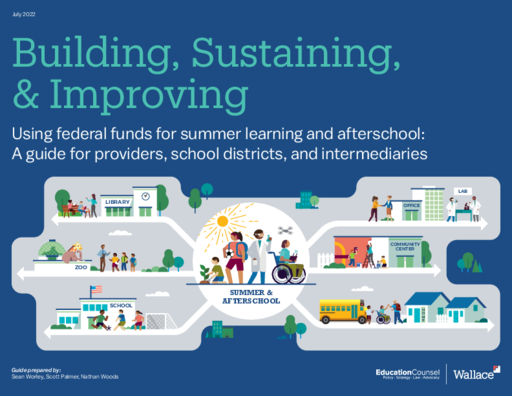Breadcrumb
- Wallace
- Reports
- Building, Sustaining And Improvi...
Building, Sustaining and Improving
Using Federal Funds for Summer Learning and Afterschool

- Author(s)
- Sean Worley, Scott Palmer, and Nathan Woods
- Publisher(s)
- EducationCounsel
Summary
How we did this
The authors of this guide have expertise in federal education policy and funding. Their sources for the publication include a review of research literature, conversations with national and local leaders in the out-of-school-time field, and an analysis of statutory language regarding the purpose and allowable uses of federal funding, and relevant guidance documents.
The guide identifies a broad variety of federal funding streams that program providers, districts, summer and afterschool intermediaries, municipal government leaders, and state government leaders can tap to support equitable access to high-quality programs. Section 1 of the guide compares key federal funding sources by intended use within afterschool and summer programs. Section 2 provides additional information for each of those funding sources. Section 3 lists additional publications and resources.
Children need places to feel safe, achieve academically, and grow socially and emotionally. High-quality summer and afterschool learning programs (also known as out-of-school-time, or OST, programs) can provide these opportunities.
This guide identifies a broad variety of federal funding streams that can be used to support access to high-quality OST programs. It is for program providers, school districts, summer and afterschool intermediaries, municipal government leaders, and state government leaders with an interest in developing, expanding, and sustaining robust OST programming. Among funding streams identified is the American Rescue Plan Act of 2021. Funds from this source can be used to cover OST program costs, plan for the future, and develop program infrastructure. The deadline for using these funds is 2024.
Federal Funding Streams and Components
The guide groups federal funding streams under three broad categories: 1) creating and sustaining equitable conditions for learning; 2) preparing for program delivery; and 3) building and aligning ecosystems of support.
It also identifies seven different elements, or components, that make up these three categories:
1) Creating and sustaining equitable conditions for learning
- Safe and supportive environments
- Relevant, rigorous, and engaging opportunities
2) Preparing for program delivery
- Planning, communication, and retention infrastructures
- Physical infrastructures
- Human capital
3) Building and aligning ecosystems of support
- Systems of continuous improvement
- Strategic partnerships
The guide identifies specific actions and considerations for each element. It also identifies the federal funding streams that apply to each action and offers brief descriptions of funding sources. It includes an appendix of relevant resources.
The Value of Strategic Partnerships
Not every stakeholder will be eligible for every federal funding stream for summer learning and afterschool programming. But strategic partnerships may provide an opportunity to access funding that would not otherwise be available. Stakeholders should consider which funding streams best apply to them. They can then explore how to work with others to blend and braid OST funding opportunities.
A related report on federal funding sources for school district programs and initiatives is:
Key Takeaways
- There are at least 20 federal funding sources available to support summer learning and afterschool programming.
- Federal funding sources for OST can be grouped into three broad categories: 1) creating and sustaining equitable conditions for learning, 2) preparing for program delivery, and 3) building and aligning ecosystems for support.
- Not every stakeholder is positioned to take advantage of every funding stream. Strategic partnerships offer organizations an opportunity to blend and braid funding, and to gain access to funding not otherwise available to them.
- Coordination, communication, and collaboration will be key to effective OST partnerships.

